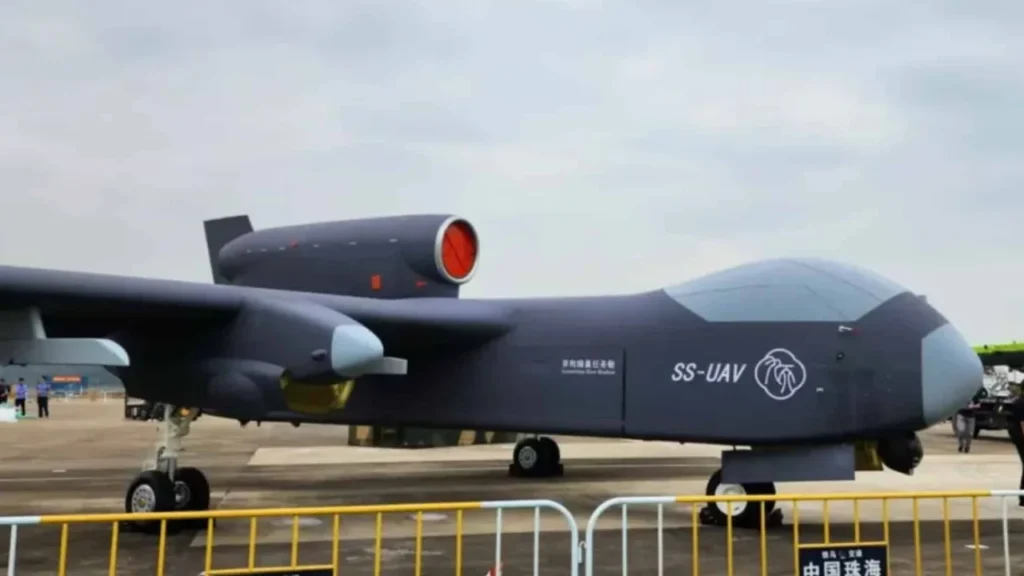China’s development of “drone motherships” is an important step in its military modernization strategy. By fusing uncrewed systems (UxS) with Artificial Intelligence (AI), Beijing aims to redefine aerial and maritime warfare — especially in scenarios involving Taiwan. The emergence of platforms like the Jiutian SS-UAV and a dedicated naval drone carrier reveals how China envisions a future dominated by intelligent warfare, where drone swarms play a central role in overwhelming traditional defenses.

Jiutian SS-UAV: The World’s First Aerial Drone Mothership
The Jiutian SS-UAV Drone Mothership, introduced at the 2024 Zhuhai Air Show, is a jet-powered, high-altitude, long-endurance (HALE) UAV built to serve as a Drone Mothership. With the ability to launch up to 100 smaller UAVs mid-flight, the platform leverages AI to orchestrate swarm behavior—a capability designed to saturate and paralyze enemy air defenses.
| Feature | Detail |
|---|---|
| Drone Capacity | Up to 100 kamikaze UAVs |
| Endurance | 12 hours |
| Range | 7,000 km (4,350 miles) |
| Altitude Capability | 15,000 meters (50,000 feet) |
| Payload Capacity | 6.6 tonnes |
| Wingspan | 82 feet |
Modular Mission Profiles
The Jiutian is not limited to drone deployment. It can be configured for multiple roles, such as
- ISR (Intelligence, Surveillance, and Reconnaissance)
- Electronic Warfare (EW)
- High-speed transport & emergency rescue
- Missile deployment (air-to-air, air-to-ground, anti-ship)
The Role of AI and UxS
AI serves as the brain of this ecosystem—guiding drone coordination, threat analysis, and mid-air tactical decisions. Using quantum-encrypted communication, it allows secure, real-time commands to swarms even in contested environments. The emphasis on AI and uncrewed systems reflects China’s broader pivot toward intelligent warfare.
Strategic Weaknesses and Criticisms
Despite its futuristic appeal, the Jiutian SS-UAV is not without controversy.
Key Concerns:
- High Visibility: The large, non-stealthy frame makes it an easy radar target.
- Vulnerability Post-Launch: Once drones are deployed, the mothership loses its offensive edge and becomes a high-value target.
- Swarm Size Limitation: Even 100 drones may not be sufficient to breach layered modern air defenses.
- Propaganda Factor: Some experts claim it’s more of a psychological weapon than a practical one — a “paper tiger” for global optics.
- Payload vs Endurance: The claimed 12-hour endurance is questionable when fully loaded with drones and missiles.
This skepticism is amplified by the rapid rise of counter-drone technologies like laser weapons, microwave systems, and India’s D4 defense grid, which are designed specifically to neutralize swarm attacks.
China’s Naval Drone Carrier: A Floating Launchpad
In addition to airborne platforms, China is also investing in sea-based drone operations. In 2022, it launched the world’s first dedicated naval drone carrier — a catamaran-hulled vessel equipped with a short flight deck suited for fixed-wing UAVs.
Design Highlights:
- Deck Size: ~⅓ length and ½ width of a U.S. supercarrier
- No Hangar Deck: Suggests low-intensity or experimental deployment
- Possible Roles:
- Simulation of adversary fleets (“Electronic Blue Force”)
- Drone swarm development and testing
- Unmanned Surface Vessel (USV) coordination
Its stealthy mission remains speculative, but it likely serves China’s strategic planning for naval uncrewed systems deployment around Taiwan and the South China Sea.
Implications for Taiwan and Global Security
The deployment of such platforms signals a clear message: China is preparing for future conflict scenarios where mass, speed, and automation dominate. A drone swarm could delay enemy response, create confusion, and saturate missile defenses — all critical elements in a Taiwan contingency where speed and first-mover advantage may dictate outcomes.
However, the reality remains that
- Counter-drone technologies are advancing rapidly worldwide.
- Stealth, survivability, and coordination are still unresolved challenges for large-scale drone swarm deployment.
- The effectiveness of AI agents in real-time battlefield scenarios remains unproven in high-intensity combat.
Conclusion
China’s drone mothership initiatives — both in the air and at sea — are redefining the rules of military engagement. By integrating AI, UAVs, and uncrewed systems into combat operations, Beijing is betting on a future where intelligent warfare supersedes traditional firepower. Whether these platforms turn out to be true strategic assets or symbolic projections of power will depend on how well they perform against emerging counter-drone systems and real-world battlefield dynamics.







